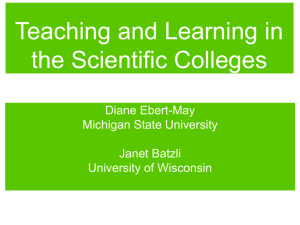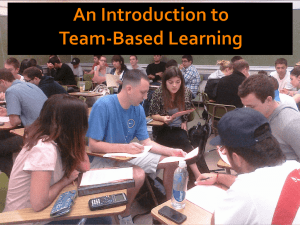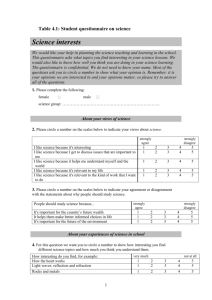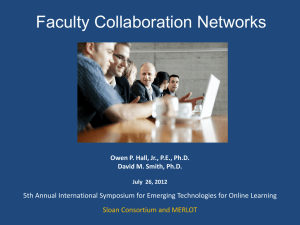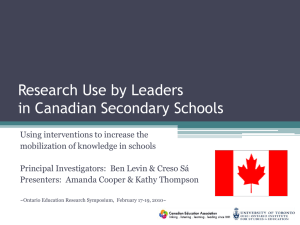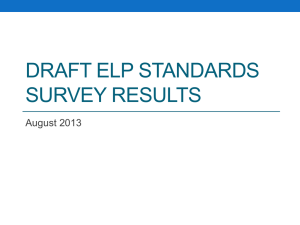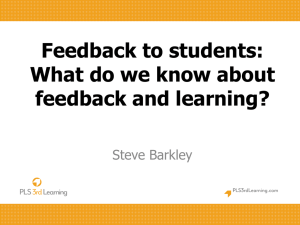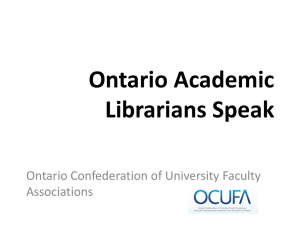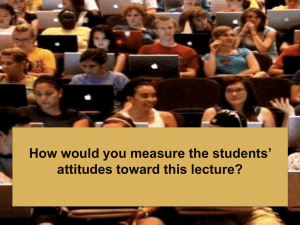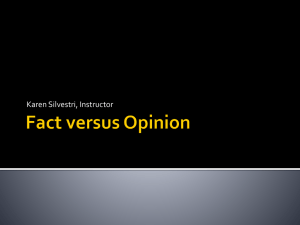Teaching for Understanding: Active Learning and Assessment
advertisement
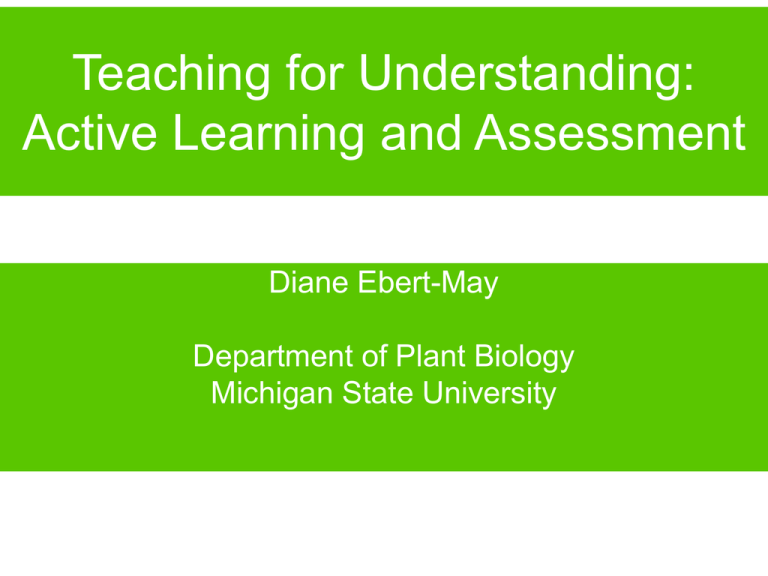
Teaching for Understanding: Active Learning and Assessment Diane Ebert-May Department of Plant Biology Michigan State University Q u ic k T im e ™ a n d a G r a p h ic s decom pr ess or a r e n e e d e d t o s e e t h is p ic t u r e . The trouble with our times is that the future is not what it used to be. -Paul Valery, The Art of Poetry Questions for you... 1.What do you expect to gain from this workshop? 2.What are your major teaching challenges? 3.What challenges do your students face in learning? 4.How did you learn science? ... think way back. 5.How do your students learn science? Engage Question 1 Please respond on a scale of 1-5: 1=strongly agree; 2=agree; 3=neutral; 4= disagree; 5=strongly disagree Active learning strategies enable students to learn science better than passive lectures. • Question 2 Please respond on a scale of 1-5: 1=strongly agree; 2=agree; 3=neutral; 4= disagree; 5=strongly disagree • Students learn science best by “doing” science. Question 3 Please respond on a scale of 0-100% in increments of 10: How important is it to use multiple kinds of assessments to determine students’ learning? • Question 4 Please respond on a scale of 0-100% in increments of 10: The proportion of assessments I use in my course that demonstrate students’ critical thinking abilities is.... • Question 5 Please respond on a scale of 1-5: 1=strongly agree; 2=agree; 3=neutral; 4= disagree; 5=strongly disagree In my department, excellence in teaching is rewarded at a level comparable to excellence in research. • Question 1 Please respond on a scale of 1-5: 1=strongly agree; 2=agree; 3=neutral; 4= disagree; 5=strongly disagree Active learning strategies enable students to learn science better than passive lectures. • Students are the tie that binds us... Class Meeting Class Meeting Question 2 Please respond on a scale of 1-5: 1=strongly agree; 2=agree; 3=neutral; 4= disagree; 5=strongly disagree • Students learn science best by “doing” science. Lila Smith 1975; in Smith el al. 2005 Teacher- to LearnerCentered Classroom • How does scientific teaching promote this transition? Lila Smith 1975; in Smith el al. 2005 Question 3 Please respond on a scale of 0-100 in increments of 10: How important is it to use multiple kinds of assessments to determine student learning? • Question 4 Please respond on a scale of 0-100 (%) in increments of 10: The proportion of assessments I use in my course that demonstrate students’ critical thinking abilities is.... • What is critical thinking? • Connections among concepts • Organization of concepts • Visual representations • Model-based reasoning • Test models • Solve problems Question 5 Please respond on a scale of 1-5: 1=strongly agree; 2=agree; 3=neutral; 4= disagree; 5=strongly disagree In my department, excellence in teaching is rewarded at a level comparable to excellence in research. • Explore What’s up with Termites? •1. On a sheet of paper, draw two circles near each other on the center of the page. •2. Release termites onto paper. •3. Keep creatures safe. I shall collect them in their original habitat. •4. What do you observe about termite behavior? •5. Develop a question your group could explore if you had more time. •(15 minutes - select a timekeeper) Learning Objective • Develop one possible learning objective for this ‘inquiry’. • What do you want students to know and be able to do? • What evidence is acceptable? Give your students a roadmap to learning…. • Benefits and costs? Explore: Out of Thin Air What is going on? • Brainstorm: talk to your neighbor and diagnose the situation from both the teacher’s and learner’s perspective. • What is the learning challenge? Misconceptions about Photosynthesis, Respiration, and the Carbon Cycle • Photosynthesis as Energy • Biomass from Soil • Energy as Biomass • All Green • Plant Altruism • Thin Air • Respiration as ‘breathing’ How and when do you identify student learning difficulties? Pre-test (e.g., specific questions - identify misconceptions) Engagement activity - brain teaser, discussion starter, ‘need to know’ questions Surveys or polls (clickers?) Others? Radish Problem in Ebert-May D, Batzli J, Lim H. 2003. Bioscience 53:1221-1228. •Experimental setup: •Weighed out 3 batches of radish seeds •each weighing 1.5 g. •Experimental treatments: •1. Seeds placed on DRY paper towels in LIGHT •2. Seeds placed on WET paper towels in LIGHT •3. Seeds placed on WET paper towels in DARK Problem (cont) After 1 week, all plant material was dried in an oven overnight (no water left) and plant biomass was measured in grams. •Predict the biomass of the plant material in the various treatments. • Light, no water Light, water Dark, water Results Mass of Radish Seeds/Seedlings 1.46 g 1.63 g 1.20 g Write an explanation about the results. Explain the results. Write individually on carbonless paper. Assessment on Midterm Hypothetical scenario: Grandma Johnson had very sentimental feelings toward Johnson Canyon, Utah, where she and her late husband had honeymooned long ago. Her feelings toward this spot were such that upon her death she requested to be buried under a creosote bush overlooking the canyon. Trace the path of a carbon atom from Grandma Johnson’s remains to where it could become part of a coyote. NOTE: the coyote will not dig up Grandma Johnson and consume any of her remains. Assessment on Final Deep within a remote forest of Guatemala, the remains of a spider monkey were buried under an enormous mahogany tree. Although rare, jaguars (big cats - carnivores) were spotted in this forest by local farmers. Explain how a carbon atom in carbohydrates contained within the muscle cells of the spider monkey could become part of a cell within the stomach lining of a jaguar. Note: the jaguar does not dig up the monkey and eat the remains! To do so... Make a clearly labeled box model of the system. Use the template on the Answer Sheet. You will not need all of the boxes. In the model, clearly label the processes (next to arrows), organisms or places, and forms (carbon pools) the carbon atom must go through to cycle within the ecosystem. Use the organisms/places and pools from the lists below. Place or Organism [not listed in a specific order] Carbon Pools [form] Atmosphere Jaguar (carnivore) Mahogany tree (producer) Bacteria (decomposer) Spider Monkey (herbivore) Tapir (similar to a pig) (herbivore) CO2 gas Carbohydrate Reminder: format for a box model: Pool Place Process Pool Place Process Pool Place Circles identify key portions of box model. Orange circles identify difficult portions for students. • How People Learn Bransford et al 1999, 2004 Explain Cooperative Learning Eric Mazur - Harvard (Dept of Physics) Peer Instruction Karl Smith - University of Minnesota (Civil Engineering Dept) Cooperative/ Collaborative Learning Regrouping What are ways of putting students into cooperative groups? Individual accountability and group responsibility with common goal..... Frustrated Student Within groups: think-pair-share Reflecting on this case, consider the following: 1. What questions and issues does this case raise? 2. As an instructor, what would you do in this situation? 3. What are the learning objectives for each class? 4. What are the students’ expections for course? 5. How do the active, in-class problems in groups motivate students to learn, or not? 6. Have you faced a similar challenge? If so, what did you learn from it? What is assessment? Data collection with the purpose of answering questions about… students’ understanding students’ attitudes students’ skills instructional design and implementation curricular reform (at multiple grain sizes) Informing BOTH instructors and students about learning. Learning Outcome • Statement that indicates level of expectation of performance. • What evidence will indicate whether students have achieved the learning objective? • (actions, behaviors that can be assessed) • What level of learning do we ask of our students? Bloom (1956) Cognitive Domain of Educational Objectives 6 categories Knowledge • Comprehension Application Analysis Synthesis Evaluation Characterize the Level of Expectation • Return to the termite learning objective.... • ...assign a Bloom level to each. % Total Qs Department of Plant Biology Course Level *N items How am I going to grade all this stuff?? Assessment Gradient High Ease of Multiple Choice, T/F Diagrams, Concept maps, Quantitative response Assessment Short answer Essay, Research papers/ reports Low Oral Interview Theoretical Framework • Ausubel 1968; meaningful learning • Novak 1998; visual representations • King and Kitchner 1994; reflective judgment • National Research Council 1999; theoretical frameworks Low Potential for Assessment of Learning High Assessment and Feedback Approaches • Subsample= You don’t need to grade everything!! • Classroom Assessment Techniques (Angelo & Cross 1993); Muddiest Point, Minute papers etc.. • Pyramid Exams- Individual 75% + Group 25% • Diagnostic Questions & Clickers • Rubrics Jigsaw Count off -- 1, 2, 3, 4, 5 All 1s work on same paper ....2s, 3s, 4s, 5s Tomorrow, return to new groups and share what you found in each of the papers. Report out Paper Assignments Group 1: Climate change.... Group 2: Novel assessments... Group 3: Unraveling complexity... Group 4: Unleashing problem solvers... Group 5: Active homework... Jigsaw •Tomorrow, return to your home group....and discuss. You should be able to answer the following: •1. What are the student learning goals? •2. What is the Bloom-level of each goal? •3. Describe the type of assessment used in the unit. •4. Do the assessments align with the goals? •5. What are the active learning strategies? Groups 1s, 2s, 3s, 4s, 5s •Group roles: •Time keeper •Reporter •Recorder •Encourager/facilitator Groups 1s, 2s, 3s, 4s, 5s • Consider one learning challenge of students at The Citadel and adapt the Pathways to Scientific Teaching ideas to one unit of instruction. • Summaries the ideas on large flip chart paper. • Reporter - gives synopsis to large group. Instructional Design How do you go about developing a unit for your course? How would you start? What would you do? Backward Design Learning Objective Identify desired results Learning Outcome Determine acceptable evidence Assessments Data collected & Feedback given Instructional Design & Activities Planned learning experiences and instruction Adapted from Wiggins and McTighe 1998, 2005 Backward Design Concept Maps are represent display connected with has has Used for Concepts Knowledge or Understanding Visual Diagrams Or Models Structure Hierarchy is constructed with Assessment Linking Words Organization Context promotes Reflection & Learning Prior Knowledge New Information For a course you teach ..... 1. Select a concept that is critical for your students to understand. 2. Identify 4 or 5 subconcepts that are important to understanding that concept e.g., DNA - Gene- Chromosome - Protein 3.Add linking lines to make connections between two concepts 4. Add linking lines that describe the relationship between concepts www.ctools.msu.edu Student’s Concept Map Rubrics Learning Objective Students will be able to demonstrate understanding of evolution and natural selection by developing and testing models and solving problems. Misconceptions: Natural Selection •Changes in a population occur through a gradual change in individual members of a population. •New traits in species are developed in response to need. •All members of a population are genetically equivalent, variation and fitness are not considered. •Traits acquired during an individual’s lifetime will be inherited by offspring. Pre-test: extended response. Explain the changes that occurred in the tree and animal. Use your current understanding of evolution by natural selection. (AAAS 1999) How do we develop rubrics? Describe the objective for the activity, problem, task... Develop criteria and performance standards for the assessment Differentiate levels of responses based on clearly described criteria Rate (assign value) the categories Student Responses Misconceptions Correct Change in the individual Change in the population Need to Change/ Must Change/ Choice Change due to genes All members of a population are equally fit Individuals within a population have varying fitness levels Traits acquired during a lifetime are passed on Genetic traits help the individual to survive and reproduce Scoring Rubric for Quizzes and Homework Level of Achievement Exemplary (5 pts) General Approach • Addresses the questi on. • States a rel evant, justi fiable answer. • Presents arguments in a logical order. • Uses acceptable style and gramm ar (no errors). Comprehension • Demonstrates an accurate and complete understandi ng of the questi on. • Backs conclusi ons wi th data and warrants. • Uses 2 or m ore ideas, examples and/or arguments that support the answer. Adequate (3 pts) • Does not address the questi on expl ici tly, al though does so tangenti all y. • States a rel evant and justi fiable answer. • Presents arguments in a logical order. • Uses acceptable style and gramm ar (one error). • Demonstrates accurate but only adequate understanding of questi on because does not back conclusions with warrants and data. • Uses only one idea to support the answer. • Less thorough than above. Needs Improvement (1 pt) • Does not address the questi on. • States no relevant answers • i ndicates misconceptions. • Is n ot clearl y or logical ly organi zed. • Fai ls to use acceptable style and gram mar (two or m ore errors). • Does not dem onstrate accurate underst anding of the quest ion. • Does not provide evidence to support their answer to the questi on. No Answer (0 pts) Ebert-May http://www.flaguide.org/cat/rubrics/rubrics1.php Advantages of Scoring Rubrics Improve the reliability of scoring written assignments and oral presentations Convey goals and performance expectations of students in an unambiguous way Convey “grading standards” or “point values” and relate them to performance goals Engage students in critical evaluation of their own performance Save time but spend it well Avida-ED Avida-ED •http://www.msu.edu/course/isb/202/ebertmay/homepage/ homework.html#hw9 Action Plan What resources from this workshop will be most helpful to you in teaching? Reflect on your lectures. What topics are challenging to teach? List two colleagues who would help you brainstorm active learning techniques to address these challenges. What type of feedback would you value from a colleague? Handelsman, Miller & Pfund 2007 Action Plan...continued Our challenge to you, try one of the strategies that you and your colleague identify, next time you teach. Open Mic Finally... •“...we note that successful people are the ones who take advantage of those around them to ultimately benefit students.” •Ebert-May D, Weber R, Hodder J, Batzli J (2006) Team at MSU •Rett Weber - Plant Biology (postdoctoral researcher) •Deb Linton - Plant Biology (C. Michigan University) •Duncan Sibley - Geology •Doug Luckie - Physiology •Scott Harrison - Microbiology (graduate student) •Tammy Long - Plant Biology •Heejun Lim - Chemistry Education •Rob Pennock - Philosophy •Charles Ofria - Engineering •Rich Lenski - Microbiolgy •Janet Batzli - Plant Biology [U of Wisconsin]
